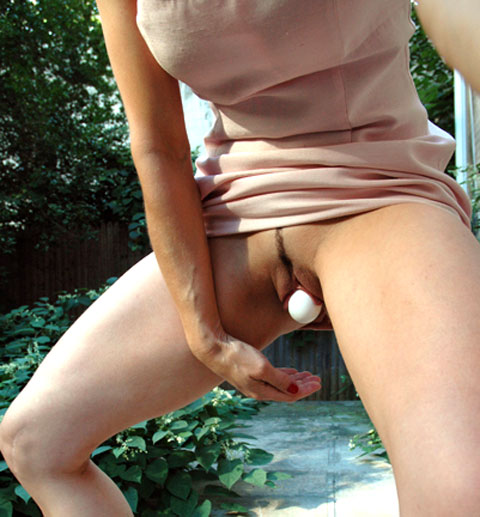
Heide Hatry Expectations IV, 2007 C-print
Since my Friday post about "Out of the Box" show at Elga Wimmer I've gone back to the desk and written a paragraph on each of the artists included in the installation:
Regina Jose Galindo's 47-minute video, "Piel" [skin], documents the artist striding very deliberately over the stones of Venice, beginning at a stone wall of a busy passage where she shears and completely shaves the hair from her body and scalp and removes all of her clothing. It ends simply, with very little drama, on a broad terrace at the edge of the Grand Canal. The performance requires the participation of both her cameraman and the many pedestrians we encounter along the way, most of them remarkably indifferent to her appearance. This piece, like many in this show, left me wondering what the effect might have been had the the artist been presenting to her collaborators a body less beautiful than the one we see here.
In the past Heide Hatry has repeatedly worked with another kind of epidermis, pigskin, and it's the one most closely related to the one we all share. In the video diptych she shows here however, which she has titled "Adaptations" [2 min 47 sec], she works with her own, and not much else. The work represents two very different, even extreme, responses to the fulfillment of the principle biological function of a woman's body, birth. We first see her naked in an leafy Eden of sorts, giving birth and immediately performing the role which society has traditionally demanded of one half of its members, that of nurturing mother. In the second segment another successful (and equally abbreviated) labor ends with a very different outcome for a young, smartly dressed professional carrying her MacBook out of that same jungle.
Sonia Khurana may first attract our attention because the proportions of her naked body represent something less than the modern ideal, but her art is what holds us, and it's the art which brings us back. "Bird" [3 min 20 sec] finds the artist in a number of excited dances magically eliciting imagery related to its title. The silence of the video and the gorgeous purple, satiny sheen and bleeding contrast of the picture is extremely attractive and a perfect instrument for this tender piece. Khurana's success in realizing her avian compulsion may be improbable, but we are first curious, then charmed, even solicitous, but finally we are captivated by the documentation of her efforts.
Carolee Schneemann is both the inspiration for and the grande dame among the artists in this show, and so perhaps that is why she is represented by two [more or less separate] pieces. The first is "Unexpectedly Research" (1992) something of a "story board" of laser prints and text representing performance work done in the twenty years after 1962. The more recent piece is the video, "Cave" (1995) [7 min 30 sec], projected high on a wall not visible until the visitor has completely entered the gallery. The sound dominates the room, and eventually the images themselves become inescapable, composed as they are of documentation of a 1995 group performance which included the artist and seven other nude women re-enacting her 1975 piece, "Interior Scroll", where she painted her body with mud slowly extracted a paper scroll from her vagina while reading from it.
He Chengyao's has always used nakedness in her art, and her art has usually related to her personal experience of growing up in a Chinese society far less open to individuality than today. Whatever difficulties she had to overcome in a rural county were magnified by a nightmare which arose from the circumstances of He's birth. Her mother suffered a nervous breakdown and subsequent insanity brought on by community displeasure and a social and economic ostracism, but the family survived together. Her mother has been a part of most of He's work that I have been able to see on line. Her mother does not appear in the piece included here, "Broadcast Exercise" (2004) [5 min], but since its traditional Chinese exercise form relates to the conventions and solidarity of a rigid society as much as to the conflicting demands of attachment and independence, her mother is not really very far away.
Considering the richness, the tragedy and the hope represented by the modern history of her ancient homeland, it's no surprise that Minette Vari's identity as a South African is very much a part of her art, but "REM" is more than an evocation of that history. It's a gorgeous strip of animation with the wondrous feeling of the earliest form of "film", more "magic lantern" than modern, manipulated video. In a dreamy, continuous loop images representing the glorious and the horrible in the geography and culture of the South African experience float behind a cut-out of Vari herself, the proportions of her torso and limbs expanding and contracting in a luxurious weightlessness. The figure is that of the artist sleeping, hence the title. The poses and the magnificent bulk of her thighs suggest the heroes found on early Greek, red-figured pottery as much as images found in Bushman cave paintings.
[image from Heide Hatry]